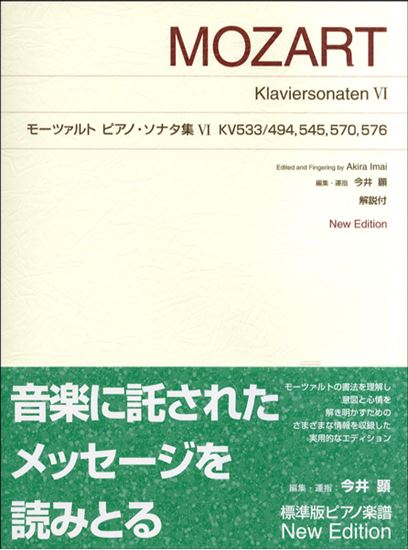Mozart, Wolfgang Amadeus : Sonate für Klavier Nr.18 (Allegro und Andante) F-Dur K.533(K.494)
Work Overview
Publication Year:1788
First Publisher:Hoffmeister
Instrumentation:Piano Solo
Genre:sonata
Total Playing Time:22 min 00 sec
Copyright:Public Domain
Additional Notes:新モーツァルト全集では、ソナタ番号が旧来の「18番」から「15番」へと変更された。
Commentary (1)
Author : Inada, Saeko
Last Updated: September 1, 2007
[Open]
Author : Inada, Saeko
The first two movements of this sonata and the finale rondo were originally separate works. According to his catalog of works, the latter rondo was entered on June 10, 1786, as "Little Rondo for Solo Piano," K. 494 (published separately the following year), and the former on January 3, 1788, as "Allegro and Andante for Solo Piano," K. 533. These were subsequently published as a three-movement "sonata" in the same year, after a revision of Rondo K. 494. This is considered Mozart's final intention and is still accepted within the sonata genre today. Therefore, although it is sometimes assigned the number 18 (No. 15 in the New Complete Edition), considering its composition dates, this work falls between No. 14, K. 457, and No. 15, K. 545.
First Movement: Allegro, F major, 2/2 time. Sonata form.
The descending figure and octave leaps of the first theme, along with the triplets of the second theme, are effectively developed, enhancing the brilliance, while contrapuntal elements are also woven throughout the movement.
Second Movement: Andante, B-flat major, 3/4 time. Sonata form.
The theme gives a very unstable impression due to its irregular phrasing and feminine cadences (ending on a weak beat). Furthermore, the chords, especially in the development section, produce an enigmatic sound accompanied by contrapuntal motion.
Third Movement: Allegretto, F major, 2/2 time. Rondo form.
Originally a small-scale rondo, when it was published as a sonata, cadenza-like passages and other elements were inserted, making it suitable as a finale. Additionally, contrapuntal treatment was added to achieve unity with the preceding movements.
Movements (3)
PTNA & Partner Channel Videos(3items)
Reference Videos & Audition Selections(3items)
Sheet Music
Scores List (13)

(株)全音楽譜出版社

(株)全音楽譜出版社

(株)全音楽譜出版社

(株)全音楽譜出版社

(株)全音楽譜出版社

(株)音楽之友社

(株)全音楽譜出版社

(株)ヤマハミュージックエンタテインメントホールディングス

(株)音楽之友社










